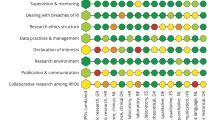Abstract
A risk-based proposal for regulating field trials—of any kind of organism—that is adaptable to any form of government regulation or institutional oversight
This is a preview of subscription content, access via your institution
Access options
Subscribe to this journal
Receive 12 print issues and online access
$209.00 per year
only $17.42 per issue
Buy this article
- Purchase on Springer Link
- Instant access to full article PDF
Prices may be subject to local taxes which are calculated during checkout
Similar content being viewed by others
References
Udelman, M. et al. 1994. Feeding 10 billion people in 2050. (Report by the Action Group on Food Security, World Resources Institute, Washington D.C).
Anonymous. 1992. FAO Yearbook (United Nations Food and Agriculture Organization, Rome).
Chrispeels, M.J. and Sadava, D.E. 1994. Plants, Genes and Agriculture (Jones and Bartlett, Boston), chapter 15.
The ability of technological advances to increase farming productivity with concomitant environmental benefits is illustrated by India's recent history with one crop affected significantly by the new technology of the Green Revolution. During the period 1961-66, Indian farmers required 13 million hectares to achieve wheat production levels of 0.83 tons per hectare. With the simultaneous adoption of genetically improved varieties and intensive crop management practices (including pest control and fertilization), production increased fivefold. Since the mid-1970s, the amount of land devoted to wheat production has leveled off at just over 20 million hectares. In the absence of these innovations, by 1991 an additional 42 million hectares would have been needed to achieve the same production level (P.E. Waggoner, How Much Land Can Ten Billion People Spare for Nature? Council for Agricultural Science and Technology, Ames, Iowa, 1994).
Goy, P.A., Chasseray, E. and Duesing, J. 1994. Agro Food Industry Hi-Tech 5: 10.
Kaiser, J. 1994. Science 266: 1935.
Hughesman, M. 1995. BioWorld Today January 9, pg.2.
Miller, H.I. in: Biotechnology, 1995. D. Brauer, Ed. (VCH, Weinheim, Germany).
Huttner, S.L. in: Biotechnology 1995. D. Brauer, Ed. (VCH, Weinheim, Germany).
Hatmaker, D. unpublished data of USDA.
Ratner, M. 1990. Bio/Technology 8: 196.
Rabino, I. 1994. Science, Technology & Human Values 16: 70.
Anonymous. 1993. Emerging Biotechnologies in Agriculture: Issues and Policies, Progress Report XII (Institute of Food and Agricultural Sciences, Gainesville FL).
Anonymous. 1994. Biotechnology Risk Control (Luxembourg, Office for Official Publications of the European Communities).
Ward, M. 1993. Bio/Technology 11: 1213.
Anonymous. 1993. Fed. Regist. 58: 17044.
Anonymous. 1994. Eur. Biotech. Information Service Newsletter 4: 6.
Anonymous. 1993. Agbiotech News Information 5: 86N.
Anonymous. 1992. Release of organisms into the environment: Voluntary code of conduct. Biotech Forum Europe 9: 218.
Miller, H.I. 1995. Is the biodiversity treaty a bureaucratic time bomb? In: Essays in Public Policy (The Hoover Institution Press, Stanford, CA).
Anonymous. 1987. Introduction of Recombinant DNA-Engineered Organisms into the Environment: Key Issues (Council of the U.S. Academy of Sciences, National Academy Press, Washington, D.C.).
Anonymous 1989. Field Testing Genetically Modified Organisms: Framework for Decisions (U.S. National Research Council, National Academy Press, Washington, D.C.).
For example, there is limited gene flow from maize to teosinte (and vice versa), and such gene flow appears neither to be detrimental to the teosintes nor to change their basic nature as distinctive wild races and species (22). Thus, even in areas where teosinte is present, maize could be categorized as of negligible risk (Category 1). By contrast, distinct varieties of oilseed (canola) rape (Brassica napus) with widely differing concentrations of erucic acid and intended for different applications should be kept segregated to avoid outcrossing between varieties; thus, high-erucic acid canola could be classified as category 1 in regions where that variety of the plant is grown but perhaps category 4 where low-erucic acid canola is grown.
Anonymous 1988. Biosafety in Microbiological and Biomedical Laboratories (Centers for Disease Control/ National Institutes of Health, U.S. Department of Health & Human Services, U.S. Government Printing Office, Washington D.C.).
Frommer, W., et al. 1989. Appl. Microbiol. Biotechnol. 30: 541.
Miller, H.I. et al. 1990. Science 250: 490.
Under the U. S. Federal Insecticide, Fungicide, and Rodenticide Act (FIFRA) and the Toxic Substances Control Act (TSCA), the EPA has not traditionally required case by case reviews for small scale field trials. Under FIFRA, field trials of chemicals or microorganisms on less than 10 acres were considered automatically not to require EPA's review and were exempt from regulation. There was a similar exemption under TSCA of chemicals or microorganisms for “small quantities solely for R&D.” While these approaches can hardly be said to be risk-based—they exempted both low-risk and other organisms alike—there was a certain logic: Namely, that small-scale experiments generally are not of great safety concern. Under these exemptions, R&D was performed on thousands of microorganisms, for purposes as varied as pesticides, frost prevention, enhanced artificial snowmaking, promoting the growth of plants, mining, oil recovery, bioremediation, and sewage treatment.
The traditional U. S. Plant Pest Act regulations contain a single inclusive list of proscribed plant pathogens, without any sub-stratification. More recent regulations under the Plant Pest Act (11) do contain a subcategory that requires only notification rather than an environmental assessment, but the subcategory is not defined according to risk-based criteria (25,26).
Author information
Authors and Affiliations
Rights and permissions
About this article
Cite this article
Miller, H., Altman, D., Barton, J. et al. An Algorithm for the Oversight of Field Trials in Economically Developing Countries. Nat Biotechnol 13, 955–959 (1995). https://doi.org/10.1038/nbt0995-955
Issue Date:
DOI: https://doi.org/10.1038/nbt0995-955
This article is cited by
-
Time for a New EU Regulatory Framework for GM Crops?
Journal of Agricultural and Environmental Ethics (2017)



